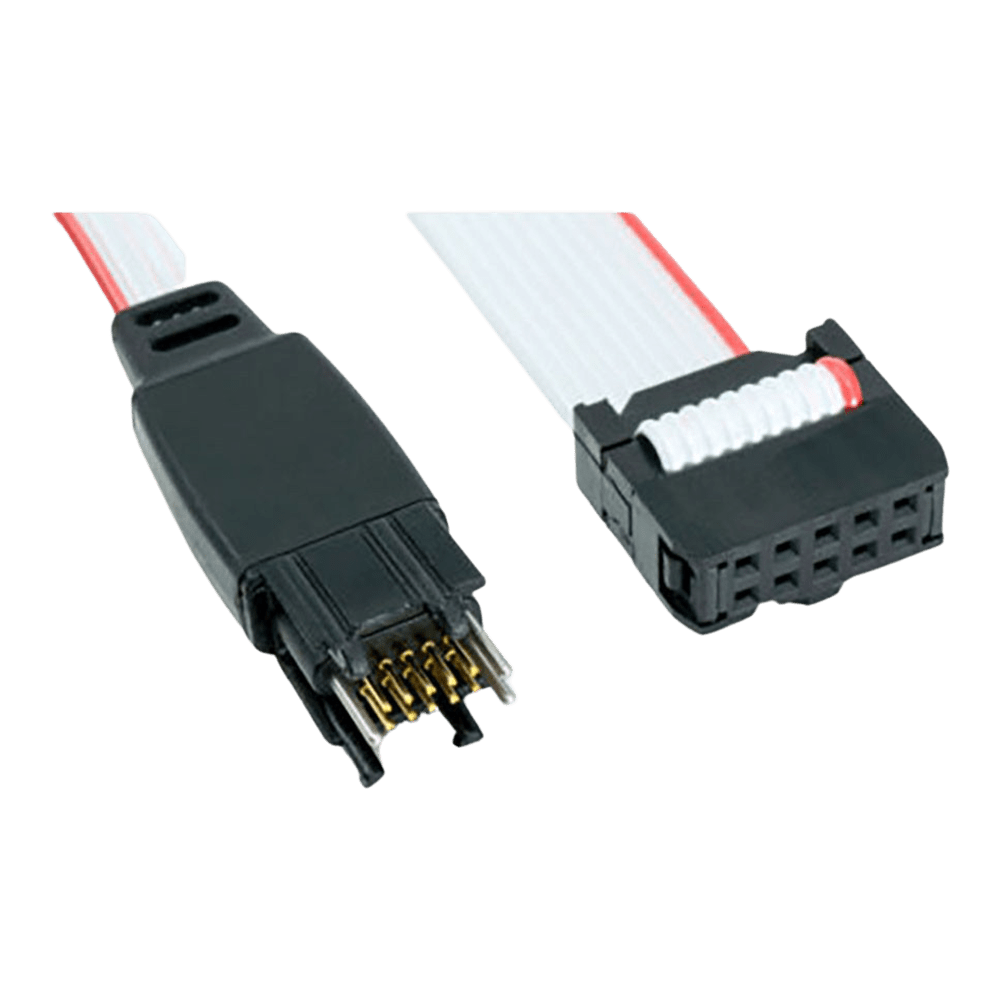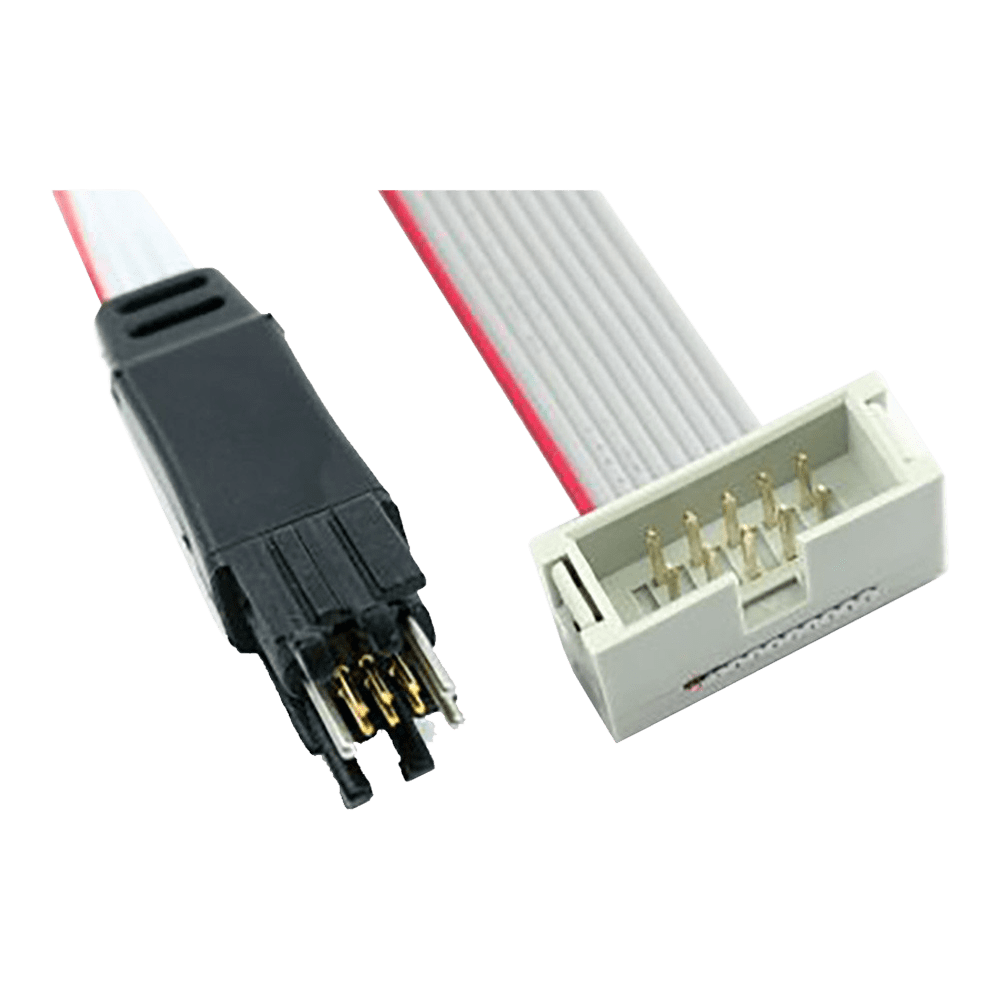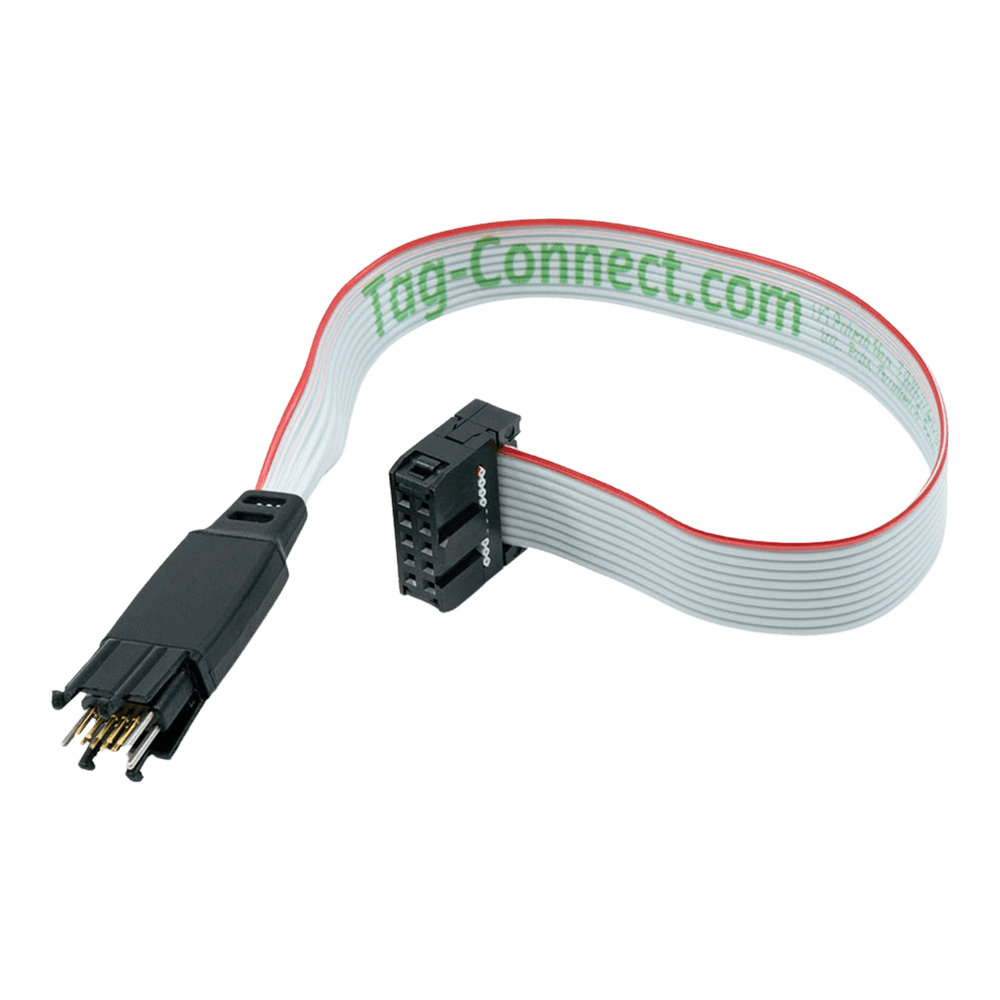


Key Features
Overview
The Tag-Connect TC2050-IDC is a 10-conductor, legged Plug-of-Nails™ programming/debug cable designed to land directly on a small PCB footprint, eliminating the need for a fitted header. A spring-pin tag-connector mates with pads and locating holes on the target board, while the opposite end terminates in a standard 0.1″ IDC ribbon for straightforward connection to adapters and debuggers.
This format is widely used for JTAG and ARM SWD tasks across MCUs, FPGAs and CPLDs. The legged design positively latches into the footprint for a secure, hands-free connection during extended debug sessions. For setups that favour a hand-held approach or maximum footprint minimisation, consider the TC2050-IDC-NL (no-legs). If you need a direct 0.05″ micro-header connection (e.g., ULINK2/FTSH-105), see TC2050-IDC-050. To connect from a 20-pin ARM header, pair this cable with the TC2050-ARM2010 adapter.
Engineers choose TC2050 because it saves board space, removes an extra BOM line, and standardises a reliable connection method across development and production. If your design uses thicker PCBs, a LONGLEGS variant is available. Follow the datasheet footprint guidelines to ensure reliable, repeatable contact.
Downloads
Why Engineers Choose The Tag-Connect TC2050-IDC Plug-of-Nails™ 10-Pin IDC Cable
Space & BOM Savings
Stable Hands-Free Debug
Toolchain Flexibility
Tag-Connect's TC2050-IDC "Legged" Plug-of-Nails™ programming cable is a 10-conductor cable fitted with a spring-pin Tag-Connector that conveniently plugs directly into your PCB and terminates in a 0.1″ ribbon connector.
- Plugs straight to your PCB – No mating connector or header required!
- Requires only a tiny footprint of pads and locating holes in your PCB.
- Zero Cost Per Board!
- Tiny Footprint!
- High-Reliability Spring-Pins make a Secure Connection and are rated for over 100,000 operations.
- Footprint has no height and can reduce the size and space requirements of your PCB.
- A great way to make test and debug signals available at no cost and with minimal board space.
Tag-Connect cables provide a simple, reliable means of connecting Debuggers and Programmers or other test equipment to your PCB's while lowering board costs and facilitating efficient production programming. Tag-Connect uses a specially designed (Patent Pending) connector which eliminates the need for putting a programming header or other mating connector on every PCB. Instead, Tag-Connect uses tried and tested spring-pins rated for over 100,000 operations to make a secure connection to a special footprint pattern of pads and locating holes in your PCB.
The legged version footprint takes about the same board space as two or three SMT resistors which means you can locate the footprint right next to the MCU if desired.
This 10-conductor cable has a TC2050 Tag-Connector on one end and a standard 0.1″ ribbon connector on the other and is suitable for use with most many MCUs / FPGAs and JTAG programming and debug operations.
A growing range of adaptors are available for specific and generic applications such as Xilinx SPARTAN and VERTEX FPGAs, TI MSP430 (TC2050-IDC-430), etc
| General Information | |
|---|---|
Part Number (SKU) |
TC2050-IDC
|
Manufacturer |
|
| Physical and Mechanical | |
Weight |
0.1 kg
|
| Other | |
Warranty |
|
HS Code Customs Tariff code
|
|
EAN |
5055383606764
|
Frequently Asked Questions
Have a Question?
-
Is there a hands-free option for no-legs footprints?
Yes—use a retaining clip/fixture with TC2050-IDC-NL to hold the plug in place during debug.
-
How does this compare with premium needle-adapters?
Needle-adapters from debugger vendors also land on pads, but Tag-Connect’s board-side legs give mechanical retention and the ecosystem supports multiple tools via adapters.
-
Any footprint do’s and don’ts?
Follow the datasheet: keep-out near pads, avoid solder paste on pads, and place the NPTHs for legs/alignment to spec.
-
How many mating cycles can I expect?
The spring-pins are rated for over 100,000 operations when used within the datasheet guidelines.
-
Does it support both JTAG and SWD?
Yes. The cable is commonly used for JTAG (IEEE-1149.1) and ARM SWD workflows when wired via the matching adapter.
-
When would I choose the no-legs TC2050-IDC-NL instead?
Choose no-legs for the smallest footprint or when a hand-held or clip-retained connection is preferred in production programming.
-
Is it compatible with SEGGER J-Link, ST-Link, ULINK and similar tools?
Yes—use the appropriate adapter (e.g., TC2050-ARM2010 for 20-pin ARM headers, or the 0.05″ variants for micro-headers) to connect to your toolchain.
-
How is this different from a standard 10-pin Cortex header?
The cable lands on a small footprint so the target PCB doesn’t carry a mating header; that saves space and removes a BOM part, while still supporting JTAG/SWD via adapters.
-
What does “legged” mean on the TC2050-IDC?
It refers to plastic retention legs that engage locating holes in the PCB footprint, providing a stable, hands-free connection during longer debug sessions.



